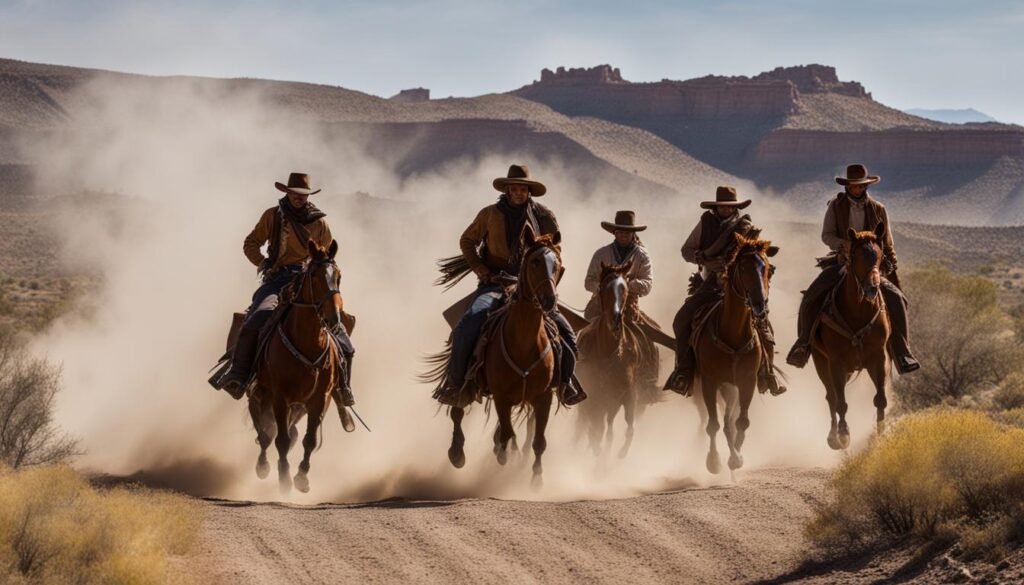Hey there! Welcome to my article on the fascinating topic of the Pony Express. If you’re a history buff or just curious about how mail was delivered in the 1800s, you’re in for a treat. The Pony Express revolutionized communication in the American frontier and left an indelible mark on our nation’s history.
So, what exactly was the Pony Express? It was a horseback mail service that operated from April 1860 to October 1861. The Pony Express was known for its incredible speed and efficiency, delivering mail in just 10 days on average. Can you imagine receiving a letter in just 10 days when other methods took weeks or even months?
The Pony Express had nearly 200 relief stations spread across several states, including Missouri, Kansas, Nebraska, Colorado, Wyoming, Utah, Nevada, and California. This vast network of stations ensured swift delivery of mail across long distances. In fact, the company’s personal best was delivering Abraham Lincoln’s inaugural address from Nebraska to California in just seven days and 17 hours!
Key Takeaways:
- The Pony Express revolutionized communication in the American frontier.
- It operated from April 1860 to October 1861.
- The Pony Express delivered mail in just 10 days on average.
- It had nearly 200 relief stations across several states.
- The company’s personal best was delivering Abraham Lincoln’s inaugural address in just seven days and 17 hours.
History of the Pony Express
The Pony Express was established in response to the need for fast mail service beyond the Rocky Mountains. It began operations in April 1860 and ran for 18 months until October 1861. The idea for a speedier mail system came from California Sen. William M. Gwin, who suggested it to the freighting firm Russell, Majors, and Waddell. Congress authorized the building of a transcontinental telegraph line in June 1860, eventually leading to the demise of the Pony Express. The transcontinental telegraph line was completed on October 24, 1861, and the Pony Express ceased operations just two days later.
The history of the Pony Express is a testament to the innovative spirit of the American frontier. As the demand for faster mail delivery grew, the Pony Express emerged as a solution. It quickly became an important link between the East and the West, delivering mail and news at unprecedented speed.
During its short but remarkable existence, the Pony Express faced numerous challenges and showcased the bravery and determination of its riders. The next section will delve into how the Pony Express worked, exploring its unique system of horse-and-rider relays and the infrastructure that supported its operations.
How the Pony Express Worked
The Pony Express operated on a meticulously coordinated system of horse-and-rider relays to deliver mail swiftly across the American frontier. Efficiency and speed were the core principles of this revolutionary mail service.
The Pony Express riders embarked on their daring journeys, traveling at breakneck speeds between stations strategically positioned along the route. These stations were typically located every 10-15 miles, ensuring a continuous flow of mail delivery.

The Riders and Stations
The Pony Express employed brave and skilled riders who risked their lives to deliver the mail. On average, a Pony Express rider weighed between 100 and 125 pounds. Considering the rugged terrain and the need for speed, riders were chosen for their agility and endurance.
Approximately 190 stations were strategically positioned along the Pony Express route, spanning states such as Missouri, Kansas, Nebraska, Colorado, Wyoming, Utah, Nevada, and California. At each station, riders would hand off the mail to a fresh courier who would continue the journey, ensuring uninterrupted mail delivery.
The Mochilla and the Oath
One of the key elements of the Pony Express mail service was the specially designed mailbag known as a “mochilla.” This lightweight yet durable bag could hold up to 20 pounds of mail and acted as a secure container during the demanding rides.
Moreover, Pony Express riders were required to take a loyalty oath, emphasizing their dedication to the safe and prompt delivery of the mail. This oath ensured the riders’ commitment to the critical task at hand, making the Pony Express operation even more reliable.
Overall, the Pony Express relied on the coordination between riders, stations, and the efficient use of the mochilla to carry out its revolutionary mail delivery service. It was an awe-inspiring feat of organization and endurance that set a new standard for communication in the American frontier.
Impact of the Pony Express
The Pony Express had a significant impact on communication in the American frontier. It provided a faster and more reliable mail service compared to other methods available at the time. The Pony Express facilitated the exchange of important news, government dispatches, and business documents. This efficient mail delivery system played a crucial role in connecting the East to the West and bridging the communication gap in the expanding United States.
The Pony Express became a legendary symbol of the pioneering spirit and the Wild West. Its riders braved harsh weather conditions, treacherous terrains, and potential attacks to ensure the prompt and secure delivery of mail. The speed and dedication of these riders captured the imagination of the public and left a lasting impression on the American frontier.
Why the Pony Express Ended
The Pony Express, despite its remarkable speed and efficiency, faced various challenges that ultimately led to its demise. One of the key factors was the company’s continuous financial struggle. From the very beginning, the Pony Express failed to generate a profit, making it difficult to sustain its operations.
An unfortunate event that further burdened the Pony Express was the Pyramid Lake War between the United States and the Paiute Indians. This conflict temporarily halted the service and resulted in significant financial losses for the company. The expenses incurred during the war exacerbated the already precarious financial situation of the Pony Express.
Furthermore, the Pony Express struggled to secure a government mail contract, which would have immensely benefited its financial stability. Without a government contract, the company relied solely on private funding and revenue from mail delivery fees.
Due to these financial difficulties, the Pony Express eventually folded in October 1861. The company reportedly suffered losses amounting to as much as $200,000, leading to its ultimate downfall.
Another critical factor that contributed to the end of the Pony Express was the completion of the transcontinental telegraph line. On October 24, 1861, the transcontinental telegraph line was officially completed at Salt Lake City, rendering the Pony Express obsolete.
The telegraph line provided fast and instant communication across the country, overshadowing the Pony Express’s comparative speed advantage. The ability to send messages rapidly and efficiently via telegraph made the Pony Express’s mail delivery service less desirable and economically impractical.

Fascinating Stories of the Pony Express
The Pony Express has left behind a legacy of captivating stories that highlight its extraordinary history. From remarkable feats of endurance to tragic encounters, the tales of the legendary horseback mail delivery service continue to intrigue and inspire.
One of the most legendary stories of the Pony Express is the remarkable accomplishment of Pony Bob Haslam. In a daring display of speed and determination, Haslam completed a 380-mile run in less than two days, setting a record for the Pony Express. His incredible feat showcases the extraordinary dedication and bravery of the riders who carried the mail across treacherous terrain and hostile territories.
Riders on the Pony Express faced immense challenges on their arduous journeys. From severe weather conditions to rugged landscapes, they braved it all to ensure the swift delivery of mail. The Pony Express riders encountered the constant threat of attacks by bandits and Native American tribes, making their journeys even more perilous. Despite these dangers, they persevered with unwavering courage and commitment.
The Pony Express stations themselves were not immune to conflict. During the Pyramid Lake War, there were reports of attacks on Pony Express stations. These attacks resulted in the tragic deaths of stock keepers who worked tirelessly to support the mail delivery operations. These incidents highlight the sacrifices made by those involved in the Pony Express and the risks they faced.
Beyond the riders and stations, the Pony Express also owes part of its enduring memory to the efforts of Buffalo Bill Cody. While not a Pony Express rider himself, Cody played a significant role in preserving the legacy of the Pony Express. Through his Wild West shows, he captivated audiences with dramatic reenactments and thrilling performances that showcased the daring spirit of the iconic horseback mail delivery service.
Conclusion
The Pony Express was an extraordinary mail service that operated in the 1800s, providing the fastest mail delivery of its time. Renowned for its speed and efficiency, the Pony Express revolutionized communication in the American frontier.
This iconic American transportation service continues to capture the imagination of people worldwide. The Pony Express holds a legendary place in history, symbolizing the pioneering spirit and the Wild West.
Despite facing financial difficulties, the Pony Express made a significant impact on communication during its brief existence. It facilitated the exchange of important news, government dispatches, and business documents, connecting the East to the West and bridging the communication gap in the expanding United States.
However, the completion of the transcontinental telegraph line ultimately led to the downfall of this remarkable mail service. Although the Pony Express may have come to an end, its legacy as the fastest mail delivery in the 1800s and an iconic symbol of American transportation remains firmly engraved in history.
FAQ
What was the Pony Express?
The Pony Express was a horseback mail service that operated from April 1860 to October 1861, revolutionizing communication in the American frontier.
How fast was the Pony Express?
On average, the Pony Express delivered mail in just 10 days. Its personal best was delivering Abraham Lincoln’s inaugural address from Nebraska to California in just seven days, 17 hours.
How did the Pony Express work?
The Pony Express relied on a system of horse-and-rider relays. Riders would travel between stations at a breakneck pace, switching horses every 10-15 miles. There were approximately 190 stations along the route, where riders would hand off the mail to a new courier.
What was the impact of the Pony Express?
The Pony Express had a significant impact on communication in the American frontier. It provided a faster and more reliable mail service compared to other methods available at the time, facilitating the exchange of important news, government dispatches, and business documents. The Pony Express also played a role in connecting the East to the West and bridging the communication gap in the expanding United States.
Why did the Pony Express end?
The Pony Express ended because of the completion of the transcontinental telegraph line. Congress authorized the building of a transcontinental telegraph line in June 1860, which eventually rendered the Pony Express obsolete. The telegraph line was completed on October 24, 1861, and the Pony Express ceased operations just two days later.
What are some fascinating stories of the Pony Express?
The Pony Express has several fascinating stories associated with its brief history. For example, Pony Bob Haslam completed a legendary 380-mile run in less than two days, setting a Pony Express record. Riders on the Pony Express had to brave extreme weather conditions, harsh terrain, and the threat of attacks by bandits and Native American tribes. There were reports of attacks on Pony Express stations during the Pyramid Lake War, resulting in the deaths of stock keepers. Buffalo Bill Cody, while not a Pony Express rider, played a significant role in preserving the memory of the Pony Express through his Wild West shows.
What is the legacy of the Pony Express?
The Pony Express was a groundbreaking mail service in the 1800s, known for its speed and efficiency. Its legacy as an iconic American transportation service and symbol of the Wild West continues to captivate people’s imagination. Despite its financial shortcomings, the Pony Express made a lasting impact on communication in the American frontier.







